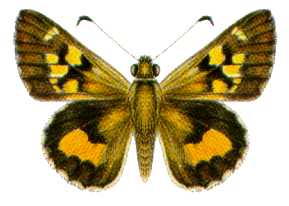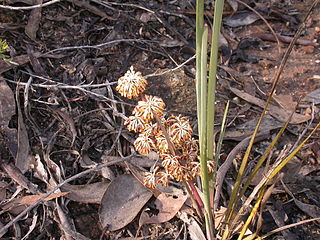
Leucaena leucocephala is a small fast-growing mimosoid tree native to southern Mexico and northern Central America and is now naturalized throughout the tropics including parts of Asia.

Lomandra longifolia, commonly known as spiny-head mat-rush, spiky-headed mat-rush or basket grass, is a perennial, rhizomatous herb found throughout eastern Australia. The leaves are 40 cm to 80 cm long, and generally have a leaf of about 8 mm to 12 mm wide. It grows in a variety of soil types and is frost, heat and drought tolerant. Labillardiere described Lomandra longifolia from a specimen collected in Tasmania.

Trapezites phigalia, commonly known as the heath ochre or phigalia skipper, is a species of butterfly in the family Hesperiidae. It is endemic to Australia, where it occurs in New South Wales, Queensland, South Australia and Victoria. It is primarily found in eucalypt woodlands, open forests, and coastal healthland habitats.
Trapezites praxedes, commonly known as the southern silver ochre or praxedes skipper, is a species of butterfly in the family Hesperiidae. It is endemic to Australia, where it occurs in New South Wales, Queensland and Victoria.
L. leucocephala may refer to:
Leucocephala, a Latin word meaning white-headed, may refer to:

Lomandra obliqua, known as fish bones and twisted mat-rush, is a small wiry ground-covering flowering plant found in eastern Australia. It is a widespread plant seen on the coast and tablelands. The foliage superficially resembles a fern, but creamy/yellow flowers form on clusters in spring. Leaves are two-ranked, somewhat glaucous and twisted.

Lomandra confertifolia is a species of perennial herbs in the genus Lomandra, Asparagaceae, subfamily Lomandroideae. It is native to Queensland, Australia. Although it appears grass-like, it is not in the grass family.

Lomandra gracilis is a perennial, rhizomatous herb found in New South Wales and Queensland in eastern Australia.

Lomandra filiformis, commonly known as wattle mat-rush, is a tussock forming perennial herb that is native to Australia. It is sparsely tufted, with strap-like leaves and yellow flowers. It grows in dry sclerophyll forest and grassy woodland, usually on well-drained rocky or sandy soils.

Lomandra spicata is a rainforest flowering plant in the family Asparagaceae. It is found in eastern Australia.
Lomandra montana is a perennial, rhizomatous herb found in eastern Australia.

Lomandra effusa is a perennial, dioecious, rhizomatous herb native to Australia. It is a perennial tussock with bluish green, large, arching leaves which are distinctive by the two toothed leaf tip. It has white, cream or pink fragrant flowers during the months of June to October.

Lomandra fluviatilis is a perennial, rhizomatous herb found in the Australian state of New South Wales.

Lomandra multiflora, also commonly known as many-flowered mat rush, mat rush and many flowered mat-lily, is a perennial, rhizomatous herb found in Australia and Papua New Guinea. The mat rush is distributed widely in the region and common within its preferred growing conditions. Its conservation status is considered not to be of concern and risk.
Lomandra patens is a perennial, rhizomatous herb found in Australia.
Lomandra collina is a perennial, rhizomatous herb found in Australia.
Lomandra glauca is a perennial, rhizomatous herb found in Australia.
Lomandra elongata is a perennial, rhizomatous herb found in eastern Australia.

Lomandra laxa is a perennial, rhizomatous herb found in the Australian states of New South Wales and Queensland.












